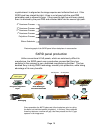Page 12
The SXRD Microdisplay
In the United States, literally hundreds of fixed-pixel projector models are
available from dozens of companies. These projectors serve every conceivable
market from home television rear projection to custom installation front projectors,
portable business projectors, fixed installation projectors, large venue projectors
and digital cinema projectors. But behind the apparent diversity, almost every
one of these projectors depends on just three types of microdisplays.
High Temperature Polysilicon Liquid Crystal Display (H-LCD) is a
transmissive technology in which the light shines through the panel. Digital
Light Processing™ (DLP™) panels use a reflective micro-mirror array. Liquid
Crystal on Silicon (LCoS) is a category of reflective panels that includes the
Direct drive Image Light Amplifier (D-ILA™) display.
From the outset, Sony was determined to create a fundamentally better
microdisplay. We set our sights on an ambitious development project, targeting
the full range of projector performance:
• High Resolution. We were committed to breaking through the
conventional limits of projector performance, delivering the first consumer
microdisplay projectors with full 1920 x 1080 HD display, and the first
commercially-available professional projectors with 4096 x 2160 resolution.
• High Pixel Density. Microdisplay panel size has an impact not only on
the cost of the panels themselves, but also on the cost of the associated
optical engine and projection lens. For this reason, Sony sought to
achieve maximum pixel count in minimum space.
• High Aperture Ratio. Aperture ratio, also known as fill factor, describes
the percentage of screen area occupied by active pixels. Larger gaps
between the pixels, such as those used in H-LCD panels, reduce the
aperture ratio and heighten the visibility of the individual pixels.
• Accurate Motion Rendering. Some displays can render still pictures
beautifully, yet introduce unwanted blur during fast motion sequences.
Slow panel switching is the culprit. Sony aimed for high switching speed.
• High Contrast Ratio. Resolution by itself does not guarantee picture
quality. Resolution and contrast work hand-in-hand to create the
perception of image detail.
• Low Dark Level. Some liquid-crystal designs tend to create milky blacks.
Sony sought to overcome this limitation.


















